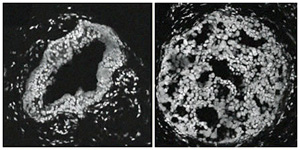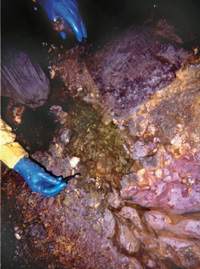
Living Systems and Quantitative Biology, page three

Using 3-D confocal microscopy and working with breast-cancer tissue samples, researchers assessed the genomic instability known to play a role in breast cancer. These images highlight regions of chromosomes in cells of a breast duct exhibiting hyperplasia (left) and one exhibiting carcinoma in situ (right).
It is estimated that close to 100 trillion cells make up a typical adult human body, and the collective properties of these cells that keep each of us alive emerge as a result of multiple interactions and linked variables. Computational models and simulations are ideal for studying the complex phenomena of life, and Berkeley Lab has been at the forefront of these so-called experiments in silico. The Laboratory has established a Scientific Cluster Support Program, in which individual micro-computers are connected through software to perform as a single high-performance processor. This program provides researchers with a cost-effective midrange computing alternative to expensive supercomputers and has already been used to obtain valuable new information about the human immune system. Berkeley Lab-UC Berkeley researcher Arup Chakraborty led a study that showed in detail how the body’s immune system is triggered into action. It was found that an intercellular junction, called the “immunological synapse,” controls the strength and duration of the signals that activate T-cells, one of the body’s principal lines of defense against infections. If problems arise at the immunological synapse, T-cell activation will be misregulated. This information could help in the treatment of autoimmunity, when T-cells mistake the body’s own cells for invaders and attack them.

The genomes of several microbial species were sequenced from this pink biofilm community, collected from acid mine drainage. Such information will help researchers in their efforts to clean up toxic waste sites.
In a separate in silico experiment, another group of Berkeley Lab-UC Berkeley researchers, led by bioengineer Adam Arkin, used computers to design a genetically modified form of the HIV virus that could prevent HIV infections from developing into AIDS. While not yet ready for synthesis into an AIDS therapy, their model, called crHIV-1 for conditionally replicating HIV-1, has performed well in computer simulations. It is yet another demonstration of why synthetic biology and in silico experiments are generating so much excitement.
To clean up toxic waste sites and study the creatures that thrive there, researchers from Berkeley Lab, the Department of Energy’s Joint Genome Institute (JGI) and UC Berkeley recently reported the first genomic characterization of a microbial community. They revealed the genetic identities of microorganisms that live in toxic conditions recovered from a natural biofilm growing in runoff from an abandoned mine. Until this work, four out of the five microbes characterized had defied laboratory culture and had only been studied in their natural habitat.
Jillian Banfield, an Earth Sciences Division scientist and a professor in UC Berkeley’s Department of Earth and Planetary Science, retrieved the sample from the depths of one of the nation’s worst Superfund sites in Iron Mountain, California. Banfield’s team then applied the screening technique known as FISH (fluorescence in situ hybridization), a microscopic technique for a gross assessment of the microbial composition, before sequencing at the JGI.
“We extensively sampled the genomes of the dominant members of one of the microbial communities we were studying. Our analyses of the assembled data have revealed a great deal about the population structure, as well as the nature of pathways central to survival of the microbial community,” says Banfield.
Eddy Rubin, Director of the Joint Genome Institute and Berkeley Lab’s Genomics Division, says, “For the first time we have managed to tease out genetic information directly from an environmental sample.”